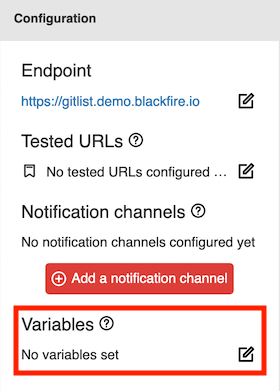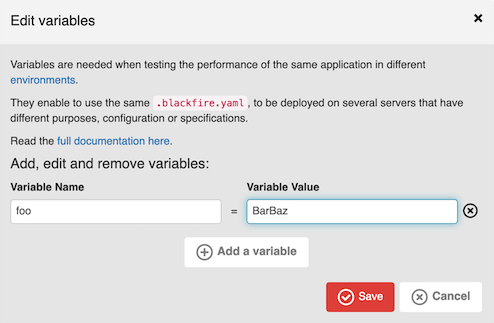Writing Scenarios
¶
Requires Production Plan
Blackfire scenarios provide a powerful way to test your application regularly, like when you deploy your code on a staging environment or in production, or when you create a pull-request to add a new feature or fix a bug. The idea is to assess the performance of your code and to check its behavior.
Scenarios are run within builds, periodic or externally triggered.
Once scenarios are completed, a Build Report is generated.
Scenarios
¶
Like Blackfire tests, scenarios are defined
in the .blackfire.yaml file:
1 2 3 4 5 6 7 8 9 10 11 12 13 14 15 16 17 18 19 20 21 22 23 24 25 26 27 28 29 30
scenarios: |
#!blackfire-player
scenario
name 'Visitor'
visit url('/pricing')
name 'Pricing page'
visit url('/docs/introduction')
name 'Documentation'
scenario
name 'Authentication'
set user_login "my_login"
set user_password "my_password"
visit url('/login')
name 'Login page'
submit button('Log in')
name 'Submit log in form'
param _username user_login
param _password user_password
follow
name 'Login redirection'
expect current_url() == endpoint ~ '/'
expect body() matches '/Welcome ' ~ user_login ~ '/'The scenarios are run by the Blackfire Player. It provides a nice DSL to crawl HTTP services, assert responses, and extract data from HTML/XML/JSON responses.
Validate your .blackfire.yaml file or test files ending with .bkf via
the Blackfire online validator.
- Writing Expectations
- Using Variables
- Writing Blackfire Assertions
- Scraping Values
Don't forget the | (pipe) at the end of the scenarios: | line to start a multiline string.
Please also note that the Player script must start with #!blackfire-player
If you trigger a build with a webhook URL, please ensure it is not an outdated version.
If the URL contains /api/v1/build/, upgrade your webhook URL by
generating a new one on the environment build's tab.
When a build is triggered, it generates a report and notifications are sent.
Variables
¶
You may use variables within your automated scenarios like for any Blackfire Player scenario. To inject values for these variables, define their key/value pairs in the Variables edition panel, available in your environment dashboard:


Build Report
¶
Build reports contain the result of all assertions written in the scenarios or in
the Tests section of the .blackfire.yaml file.
They are available from an environment's Builds section.
Build Reports have an overall status (pass or fail). The availability of a new report and its status can be sent as a notification to users with a wide variety of Notification Channels.
Builds reports have a retention policy of 13 months. Their profiles are subject to the retention policy of your plan.